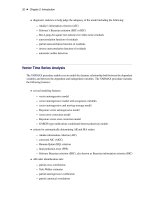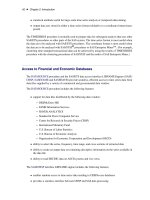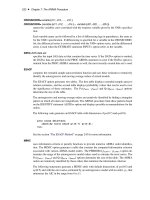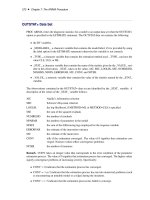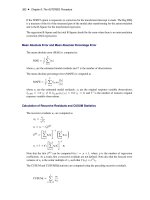SAS/ETS 9.22 User''''s Guide 162 pps
Bạn đang xem bản rút gọn của tài liệu. Xem và tải ngay bản đầy đủ của tài liệu tại đây (222.56 KB, 10 trang )
1602 ✦ Chapter 23: The SIMILARITY Procedure
NEXT
Missing values are set to the next period’s accumulated nonmissing
value. Missing values at the end of the accumulated series remain
missing.
START=option
specifies a SAS date, datetime, or time value that represents the beginning of the data. If the
first time ID variable value is greater than the START= value, the series is prepended with
missing values. If the first time ID variable value is less than the START= value, the series is
truncated. The START= and END= options can be used to ensure that data that are associated
with each BY group contain the same number of observations.
ZEROMISS=option
specifies how beginning and ending zero values (either actual or accumulated) are interpreted
in the accumulated time series. The following options can also be used to determine how
beginning and ending zero values are assigned:
NONE Beginning and ending zeros are unchanged. This is the default.
LEFT Beginning zeros are set to missing.
RIGHT Ending zeros are set to missing.
BOTH Both beginning and ending zeros are set to missing.
If the accumulated series is all missing or zero, the series is not changed.
INPUT Statement
INPUT variable-list < / options > ;
The INPUT statement lists the input numeric variables in the DATA= data set whose values are to be
accumulated to form the time series or represent ordered numeric sequences (when no ID statement
is specified).
An input data set variable can be specified in only one INPUT or TARGET statement. Any number
of INPUT statements can be used. The following options can be used with an INPUT statement:
ACCUMULATE=option
specifies how the data set observations are accumulated within each time period for the
variables listed in the INPUT statement. If the ACCUMULATE= option is not specified in
the INPUT statement, accumulation is determined by the ACCUMULATE= option of the ID
statement. If the ACCUMULATE= option is not specified in the ID statement or the INPUT
statement, no accumulation is performed. See the ID statement ACCUMULATE= option for
more details.
DIF=(numlist)
specifies the differencing to be applied to the accumulated time series. The list of differencing
orders must be separated by spaces or commas. For example, DIF=(1,3) specifies first,
INPUT Statement ✦ 1603
then third order, differencing. Differencing is applied after time series transformation. The
TRANSFORM= option is applied before the DIF= option. Simple differencing is useful when
you want to detrend the time series before computing the similarity measures.
NORMALIZE=option
specifies the sequence normalization to be applied to the working input sequence. The
following normalization options are provided:
NONE No normalization is applied. This option is the default.
ABSOLUTE Absolute normalization is applied.
STANDARD Standard normalization is applied.
User-Defined
Normalization is computed by a user-defined subroutine that is created
using the FCMP procedure, where User-Defined is the subroutine name.
Normalization is applied to the working input sequence, which can be a subset of the working
input time series if the SLIDE=INDEX or SLIDE=SEASON option is specified.
SCALE=option
specifies the scaling of the working input sequence with respect to the working target sequence.
Scaling is performed after normalization. The following scaling options are provided:
NONE No scaling is applied. This option is the default.
ABSOLUTE Absolute scaling is applied.
STANDARD Standard scaling is applied.
User-Defined
Scaling is computed by a user-defined subroutine that is created using the
FCMP procedure, where User-Defined is the subroutine name.
Scaling is applied to the working input sequence, which can be a subset of the working input
time series if the SLIDE=INDEX or SLIDE=SEASON option is specified.
SDIF=(numlist)
specifies the seasonal differencing to be applied to the accumulated time series. The list of
seasonal differencing orders must be separated by spaces or commas. For example, SDIF=(1,3)
specifies first, then third, order seasonal differencing. Differencing is applied after time series
transformation. The TRANSFORM= option is applied before the SDIF= option. Seasonal
differencing is useful when you want to deseasonalize the time series before computing the
similarity measures.
SETMISSING=option | number
SETMISS=option | number
specifies how missing values (either actual or accumulated) are interpreted in the accumu-
lated time series or ordered sequence for variables listed in the INPUT statement. If the
SETMISSING=
option is not specified in the INPUT statement, missing values are set based
on the SETMISSING= option in the ID statement. If the SETMISSING= option is not specified
in the ID statement or the INPUT statement, no missing value interpretation is performed. See
the ID statement SETMISSING= option for more details.
1604 ✦ Chapter 23: The SIMILARITY Procedure
TRANSFORM=option
specifies the time series transformation to be applied to the accumulated time series. The
following transformations are provided:
NONE No transformation is applied. This option is the default.
LOG Logarithmic transformation is applied.
SQRT Square-root transformation is applied.
LOGISTIC Logistic transformation is applied.
BOXCOX(number)
Box-Cox transformation with parameter is applied, where the real
number is between –5 and 5.
User-Defined
Transformation is computed by a user-defined subroutine that is created
using the FCMP procedure, where User-Defined is the subroutine name.
When the TRANSFORM= option is specified, the time series must be strictly positive unless a
user-defined function is used.
TRIMMISSING=option
TRIMMISSING=option
specifies how missing values (either actual or accumulated) are trimmed from the accumulated
time series or ordered sequence for variables that are listed in the INPUT statement. The
following trimming options are provided:
NONE No missing value trimming is applied.
LEFT Beginning missing values are trimmed.
RIGHT Ending missing values are trimmed.
BOTH
Both beginning and ending missing value are trimmed. This is the default.
ZEROMISS=option
specifies how beginning and ending zero values (either actual or accumulated) are interpreted
in the accumulated time series or ordered sequence for variables listed in the INPUT statement.
If the ZEROMISS= option is not specified in the INPUT statement, beginning and ending zero
values are set based on the ZEROMISS= option of the ID statement. If the ZERO= option
is not specified in the ID statement or the INPUT statement, no zero value interpretation is
performed. See the ID statement ZEROMISS= option for more details.
TARGET Statement
TARGET variable-list < / options > ;
The TARGET statement lists the numeric target variables in the DATA= data set whose values are
to be accumulated to form the time series or represent ordered numeric sequences (when no ID
statement is specified).
TARGET Statement ✦ 1605
An input data set variable can be specified in only one INPUT or TARGET statement. Any number
of TARGET statements can be used. The following options can be used with a TARGET statement:
ACCUMULATE=option
specifies how the data set observations are accumulated within each time period for the
variables listed in the TARGET statement. If the ACCUMULATE= option is not specified in
the TARGET statement, accumulation is determined by the ACCUMULATE= option in the ID
statement. If the ACCUMULATE= option is not specified in the ID statement or the TARGET
statement, no accumulation is performed. See the ID statement ACCUMULATE= option for
more details.
COMPRESS=option | (options)
specifies the sliding sequence (global) and warping (local) compression range of the target
sequence with respect to the input sequence. Compression of the target sequence is the same
as expansion of the input sequence and vice versa. The compression limits are defined based
on the length of the target sequence and are imposed on the target sequence. The following
compression options are provided:
GLOBALABS=integer
specifies the absolute global compression, where integer ranges
from zero to 10,000. GLOBALABS=0 implies no global compression,
which is the default unless the GLOBALPCT= option is specified.
GLOBALPCT=number
specifies global compression as a percentage of the length of the
target sequence, where number ranges from zero to 100. GLOBALPCT=0
implies no global compression, which is the default. GLOBALPCT=100
implies maximum allowable compression.
LOCALABS=integer
specifies the absolute local compression, where integer ranges from
zero to 10,000. The default is maximum allowable absolute local compres-
sion unless the LOCALPCT= option is specified.
LOCALPCT=number
specifies local compression as a percentage of the length of the input
sequence, where number ranges from zero to 100. The percentage specified
by the LOCALPCT= option must be less than the GLOBALPCT= option.
LOCALPCT=0 implies no local compression. LOCALPCT=100 implies
maximum allowable local compression. The default is LOCALPCT=100.
If the SLIDE=NONE or the SLIDE=SEASON option is specified in the TARGET statement,
the global compression options are ignored. To disallow local compression, use the option
COMPRESS=(LOCALPCT=0 LOCALABS=0).
If the SLIDE=INDEX option is specified, the global compression options are not ig-
nored. To completely disallow both global and local compression, use the option COM-
PRESS=(GLOBALPCT=0 LOCALPCT=0) or COMPRESS=(GLOBALABS=0 LOCAL-
ABS=0). To allow only local compression, use the option COMPRESS=(GLOBALPCT=0
GLOBALABS=0). These are the default compression options.
The preceding options can be used in combination to specify the desired amount of global
and local compression as the following examples illustrate, where
L
c
denotes the global
compression limit and l
c
denotes the local compression limit:
1606 ✦ Chapter 23: The SIMILARITY Procedure
COMPRESS=(GLOBALPCT=20) allows the global and local compression to range from
zero to L
c
D min
0:2N
y
˘
;
N
y
1
.
COMPRESS=(GLOBALPCT=20 GLOBALABS=10) allows the global and local com-
pression to range from zero to L
c
D min
0:2N
y
˘
; min
N
y
1
; 10
.
COMPRESS=(LOCALPCT=10) allows the local compression to range from zero to
l
c
D min
0:1N
y
˘
;
N
y
1
.
COMPRESS=(LOCALPCT=20 LOCALABS=5) allows the local compression to range
from zero to l
c
D min
0:2N
y
˘
; min
N
y
1
; 5
.
COMPRESS=(GLOBALPCT=20 LOCALPCT=20) allows the global compression to
range from zero to
L
c
D min
0:2N
y
˘
;
N
y
1
and allows the local compression to
range from zero to l
c
D min
0:2N
y
˘
;
N
y
1
.
COMPRESS=(GLOBALPCT=20 GLOBALABS=10 LOCALPCT=10 LO-
CALABS=5) allows the global compression to range from zero to
L
c
D
min
0:2N
y
˘
; min
N
y
1
; 10
and allows the local compression to range from
zero to l
c
D min
0:1N
y
˘
; min
N
y
1
; 5
.
Suppose
T
z
is the length of the input time series and
N
y
is the length of the target sequence.
The valid global compression limit,
L
c
, is always limited by the length of the target sequence:
0 Ä L
c
< N
y
.
Suppose
N
x
is the length of the input sequence and
N
y
is the length of the target sequence.
The valid local compression limit,
l
c
, is always limited by the lengths of the input and target
sequence: max
0;
N
y
N
x
Ä l
c
< N
y
.
DIF=(numlist)
specifies the differencing to be applied to the accumulated time series. The list of differencing
orders must be separated by spaces or commas. For example, DIF=(1,3) specifies first,
then third, order differencing. Differencing is applied after time series transformation. The
TRANSFORM= option is applied before the DIF= option. Simple differencing is useful when
you want to detrend the time series before computing the similarity measures.
EXPAND=option | (options)
specifies the sliding sequence (global) and warping (local) expansion range of the target
sequence with respect to the input sequence. Expansion of the target sequence is the same as
compression of the input sequence and vice versa. The expansion limits are defined based
on the length of the input sequence, but are imposed on the target sequence. The following
expansion options are provided:
GLOBALABS=integer
specifies the absolute global expansion, where integer ranges from
zero to 10,000. GLOBALABS=0 implies no global expansion, which is
the default unless the GLOBALPCT= option is specified.
GLOBALPCT=number
specifies global expansion as a percentage of the length of the
target sequence, where number ranges from zero to 100. GLOBALPCT=0
implies no global expansion, which is the default unless the GLOBALABS=
option is specified. GLOBALPCT=100 implies maximum allowable global
expansion.
TARGET Statement ✦ 1607
LOCALABS=integer
specifies the absolute local expansion, where integer ranges from zero
to 10,000. The default is the maximum allowable absolute local expansion
unless the LOCALPCT= option is specified.
LOCALPCT=number
specifies local expansion as a percentage of the length of the target
sequence, where number ranges from zero to 100. LOCALPCT=0 implies
no local expansion. LOCALPCT=100 implies maximum allowable local
expansion. The default is LOCALPCT=100.
If the SLIDE=NONE or the SLIDE=SEASON option is specified in the TARGET state-
ment, the global expansion options are ignored. To disallow local expansion, use the option
EXPAND=(LOCALPCT=0 LOCALABS=0).
If the SLIDE=INDEX option is specified, the global expansion options are not ignored. To com-
pletely disallow both global and local expansion, use the option EXPAND=(GLOBALPCT=0
LOCALPCT=0) or EXPAND=(GLOBALABS=0 LOCALABS=0). To allow only local expan-
sion, use the option EXPAND=(GLOBALPCT=0 GLOBALABS=0). These are the default
expansion options.
The preceding options can be used in combination to specify the desired amount of global and
local expansion as the following examples illustrate, where
L
e
denotes the global expansion
limit and l
e
denotes the local expansion limit:
EXPAND=(GLOBALPCT=20) allows the global and local expansion to range from zero
to L
e
D min
0:2N
y
˘
;
N
y
1
.
EXPAND=(GLOBALPCT=20 GLOBALABS=10) allows the global and local expansion
to range from zero to L
e
D min
0:2N
y
˘
; min
N
y
1
; 10
.
EXPAND=(LOCALPCT=10) allows the local expansion to range from zero to
l
e
D
min
0:1N
y
˘
;
N
y
1
.
EXPAND=(LOCALPCT=10 LOCALABS=5) allows the local expansion to range from
zero to l
e
D min
0:1N
y
˘
; min
N
y
1
; 5
.
EXPAND=(GLOBALPCT=20 LOCALPCT=10) allows the global expansion to range
from zero to
L
e
D min
0:2N
y
˘
;
N
y
1
and allows the local expansion to range
from zero to l
e
D min
0:1N
y
˘
;
N
y
1
.
EXPAND=(GLOBALPCT=20 GLOBALABS=10 LOCALPCT=10 LOCALABS=5) al-
lows the global expansion to range from zero to
L
e
D min
0:2N
y
˘
; min
N
y
1
; 10
and allows the local expansion to range from zero to
l
e
D min
0:1N
y
˘
; min
N
y
1
; 5
.
Suppose
T
z
is the length of the input time series and
N
y
is the length of the target sequence.
The valid global expansion limit,
L
e
, is always limited by the length of the input time series:
0 Ä L
e
< T
z
.
Suppose
N
x
is the length of the input sequence and
N
y
is the length of the target sequence.
The valid local expansion limit,
l
e
, is always limited by the lengths of the input and target
sequence: max
0;
N
x
N
y
Ä l
e
< N
x
.
MEASURE=option
specifies the similarity measure to be computed by using the working input and target sequences.
The following similarity measures are provided:
1608 ✦ Chapter 23: The SIMILARITY Procedure
SQRDEV squared deviation. This option is the default.
ABSDEV absolute deviation
MSQRDEV mean squared deviation
MSQRDEVINP mean squared deviation relative to the length of the input sequence
MSQRDEVTAR mean squared deviation relative to the length of the target sequence
MSQRDEVMIN mean squared deviation relative to the minimum valid path length
MSQRDEVMAX mean squared deviation relative to the maximum valid path length
MABSDEV mean absolute deviation
MABSDEVINP mean absolute deviation relative to the length of the input sequence
MABSDEVTAR mean absolute deviation relative to the length of the target sequence
MABSDEVMIN mean absolute deviation relative to the minimum valid path length
MABSDEVMAX mean absolute deviation relative to the maximum valid path length
User-Defined
The measure is computed by a user-defined function created by using
the FCMP procedure, where User-Defined is the function name.
NORMALIZE=option
specifies the sequence normalization to be applied to the working target sequence. The
following normalization options are provided:
NONE No normalization is applied. This option is the default.
ABSOLUTE Absolute normalization is applied.
STANDARD Standard normalization is applied.
User-Defined
Normalization is computed by a user-defined subroutine that is created by
using the FCMP procedure, where User-Defined is the subroutine name.
PATH=option
specifies the similarity measure and warping path information to be computed using the
working input and target sequences. The following similarity measures and warping path are
provided:
User-Defined
The measure and path are computed by a user-defined subroutine that is cre-
ated by using the FCMP procedure, where User-Defined is the subroutine
name
For computational efficiency, the PATH= option should be only used when you want to
compute both the similarity measure and the warping path information. If only the similarity
measure is needed, use the MEASURE= option. If you specify both the MEASURE= and
PATH= option in the TARGET statement, the PATH= option takes precedence.
SDIF=(numlist)
specifies the seasonal differencing to be applied to the accumulated time series. The list of
seasonal differencing orders must be separated by spaces or commas. For example, SDIF=(1,3)
TARGET Statement ✦ 1609
specifies first, then third, order seasonal differencing. Differencing is applied after time series
transformation. The TRANSFORM= option is applied before the SDIF= option. Seasonal
differencing is useful when you want to deseasonalize the time series before computing the
similarity measures.
SETMISSING=option | number
SETMISS=option | number
option specifies how missing values (either actual or accumulated) are interpreted in the
accumulated time series for variables that are listed in the TARGET statement. If the SET-
MISSING= option is not specified in the TARGET statement, missing values are set based on
the SETMISSING= option in the ID statement. If the SETMISSING= option is not specified
in the ID statement or the TARGET statement, no missing value interpretation is performed.
See the ID statement SETMISSING= option for more details.
SLIDE=option
specifies the sliding of the target sequence with respect to the input sequence. The following
slides are provided:
NONE
No sequence sliding. The input time series is compared with the target
sequence directly with no sliding. This option is the default.
INDEX
Slide by time index. The input time series is compared with the target
sequence by observation index.
SEASON
Slide by seasonal index. The input time series is compared with the target
sequence by seasonal index.
The SLIDE= option takes precedence over the COMPRESS= and EXPAND= options.
TRANSFORM=option
specifies the time series transformation to be applied to the accumulated time series. The
following transformations are provided:
NONE No transformation is applied. This option is the default.
LOG Logarithmic transformation is applied.
SQRT Square-root transformation is applied.
LOGISTIC Logistic transformation is applied.
BOXCOX(number)
Box-Cox transformation with parameter is applied, where the real
number is between –5 and 5
User-Defined
Transformation is computed by a user-defined subroutine that is created by
using the FCMP procedure, where User-Defined is the subroutine name.
When the TRANSFORM= option is specified, the time series must be strictly positive unless a
user-defined function is used.
1610 ✦ Chapter 23: The SIMILARITY Procedure
TRIMMISSING=option
TRIMMISS= option
specifies how missing values (either actual or accumulated) are trimmed from the accumulated
time series or ordered sequence for variables that are listed in the TARGET statement. The
following trimming options are provided:
NONE No missing value trimming is applied.
LEFT Beginning missing values are trimmed.
RIGHT Ending missing values are trimmed.
BOTH
Both beginning and ending missing values are trimmed. This is the default.
ZEROMISS=option
specifies how beginning and ending zero values (either actual or accumulated) are interpreted in
the accumulated time series or ordered sequence for variables listed in the TARGET statement.
If the ZEROMISS= option is not specified in the TARGET statement, beginning and ending
values are set based on the ZEROMISS= option in the ID statement. See the ID statement
ZEROMISS= option for more details.
Details: SIMILARITY Procedure
You can use the SIMILARITY procedure to do the following functions, which are done in the order
shown. First, you can form time series data from transactional data with the options shown:
1. accumulation ACCUMULATE= option
2. missing value interpretation SETMISSING= option
3. zero value interpretation ZEROMISS= option
Next, you can transform the accumulated time series to form the working time series with the
following options. Transformations are useful when you want to stabilize the time series before
computing the similarity measures. Simple and seasonal differencing are useful when you want to
detrend or deseasonalize the time series before computing the similarity measures. Often, but not
always, the TRANSFORM=, DIF=, and SDIF= options should be specified in the same way for both
the target and input variables.
4. time series transformation TRANSFORM= option
5. time series differencing DIF= and SDIF= option
6. time series missing value trimming TRIMMISSING= option
7. time series descriptive statistics PRINT=DESCSTATS option
Accumulation ✦ 1611
After the working series is formed, you can treat it as an ordered sequence that can be normalized or
scaled. Normalizations are useful when you want to compare the “shape” or “profile” of the time
series. Scaling is useful when you want to compare the input sequence to the target sequence while
discounting the variation of the target sequence.
8. normalization NORMALIZE= option
9. scaling SCALE= option
After the working sequences are formed, you can compute similarity measures between input and
target sequences:
10. sliding SLIDE= option
11. warping COMPRESS= and EXPAND= option
12. similarity measure MEASURE= and PATH= option
The SLIDE= option specifies observation-index sliding, seasonal-index sliding, or no sliding. The
COMPRESS= and EXPAND= options specify the warping limits. The MEASURE= and PATH=
options specify how the similarity measures are computed.
Accumulation
If the ACCUMULATE= option is specified in the ID, INPUT, or TARGET statement, data set
observations are accumulated within each time period. The frequency (width of each time interval) is
specified by the INTERVAL= option in the ID statement. The ID variable contains the time ID values.
Each time ID value corresponds to a specific time period. Accumulation is particularly useful when
the input data set contains transactional data, whose observations are not spaced with respect to any
particular time interval. The accumulated values form the time series, which is used in subsequent
analyses.
For example, suppose a data set contains the following observations:
19MAR1999 10
19MAR1999 30
11MAY1999 50
12MAY1999 20
23MAY1999 20
If the INTERVAL=MONTH is specified, all of the preceding observations fall within three time
periods of March 1999, April 1999, and May 1999. The observations are accumulated within each
time period as follows:
If the ACCUMULATE=NONE option is specified, an error is generated because the ID variable
values are not equally spaced with respect to the specified frequency (MONTH).
